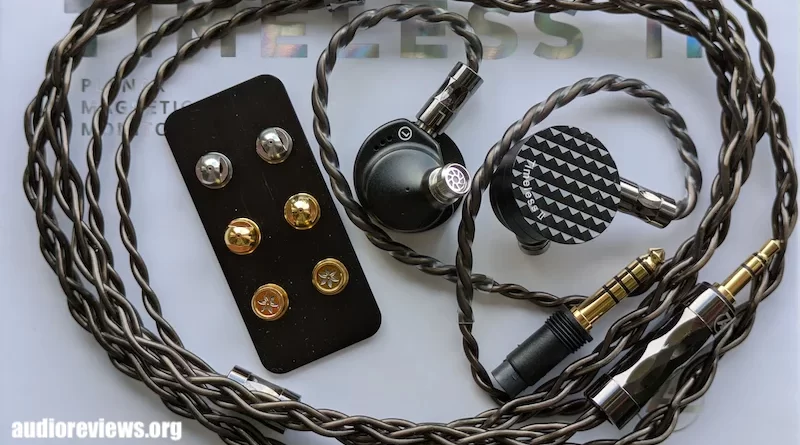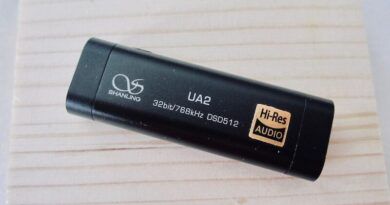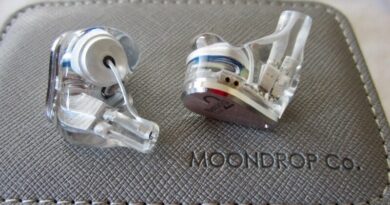7Hertz Timeless II REVIEW – Second Opinion
Having been a fan of the original Timeless – I bought one myself – I was interested to hear this second version. Much as the V1 divided our opinions here, it seems the V2 might also: to me, Timeless II is an improvement. This review focuses on comparing/contrasting the two versions.
PROS
- Tonal & technical improvement on the original, which was already (to me) good
- Interchangeable nozzles for different tonalities
- Balanced & SE-capable cable
CONS
- Tricky fit, even if they do go in your ears
- Bass might be too much for some
- Driveability better than the originals, but still like power
- The 2 ‘dome’ nozzles give odd spatial portrayal
Table of Contents
Introduction and Physical Things
While there had been earlier attempts, the original 7Hertz Timeless were arguably the first planar magnetic IEMs to really get people excited. Subsequently, many manufacturers have jumped on the planar bandwagon – even mixing planar drivers with other technologies in multi-driver models – but with the exception of the LETSHUOER S12, which came out shortly after the Timeless, these later attempts haven’t generated the same amount of enthusiasm.
In attempting to improve on their popular original, 7Hertz had to walk a fine line. The result is a completely new driver and mounting system, interchangeable nozzles, a new cable and connectors, and a supposedly redesigned enclosure (which nonetheless looks very similar to the original). Before getting into the sonics, t’s worth considering these differences in some detail.
The new drivers are slightly bigger than the old, 14.5mm vs 14.2. The publicity waxes lyrical about the diaphragm having a 2-sided coating (“world’s first!”), which is said to give the membrane a greater surface tension. Comparing the exploded views shown on the boxes, the most striking difference to me is the apparently denser conductor traces on the Timeless II, there looking to be a greater length of wire packed on to the (fractionally) larger diaphragm.
The structure of the two magnet arrays is also different, but any other differences are not obvious because the two pictures are drawn from different perspectives. The resulting electrical characteristics are slightly different, Timeless II having fractionally greater impedance (15.2 vs 14.8 Ohms) and slightly greater sensitivity/efficiency (108 vs 104 dB/V or 90 vs 86 dB/mW) than the original model.
Accessories provided include the same 11 pairs of tips as came with the originals – none of which I liked, my favourites with these being the JVC Spiral Dots; a new 4-core single-crystal copper cable with 2-pin connectors and interchangeable 4.4mm Pentaconn (but not 2.5mm) balanced and 3.5mm SE plugs (vs the choose-it-at-purchase 4.4 or 2.5mm balanced or 3.5mm SE silver-plated MMCX cable of the originals); and, importantly for the sonics, interchangeable nozzles (4 pairs) vs the fixed nozzles of the original Timeless. Having the option to go balanced is useful, as these things do benefit from the extra power of a balanced output where it’s available. About the nozzles, more below under Sonics.
Externally, aside from the waffled faceplates of the new version vs the subtle concentric milling on the old ones, physical differences are subtle: the enclosures are slightly deeper (see photo below) but the other dimensions are the same. This is important not only when considering whether the things will even fit in your ears, but also the sonics: I suspect one of the reasons the original Timeless was polarizing is because of how the combination of the positions of the vents, the nozzle angles, and most especially the large shells interacts with different ear anatomies.
If you found aspects of the tonality objectionable from the originals, it’s unlikely the new version will correct that for you (particularly the mid-bass; see Jürgen’s two reviews). On the other hand, if you found the originals mostly good tonally but wished for improvements in timbre and technicalities (Alberto), read on…
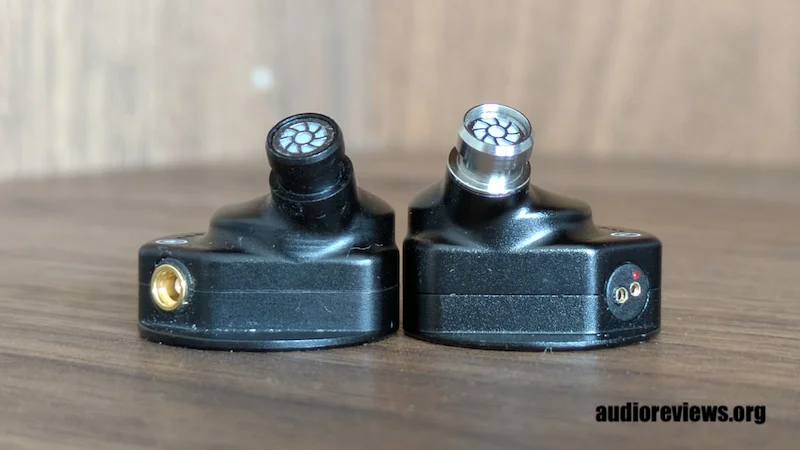
Sonics
With a few minor reservations, I really enjoyed both the tonal balance and the technical performance of the original 7Hertz Timeless. I found the bass strong down low, elevated but a bit soft in the mid and upper, and somewhat disconnected from lean-textured lower mids, but these aspects were partly ameliorated by using JVC Spiral Dot tips.
The mids and highs, while impressively smooth and clean, are also a bit thin and dynamically soft. I found the original Timeless to synergize best with warmish sources with strong dynamics. Accordingly, I did most of my listening to the Timeless II from the balanced output of the Earmen Sparrow, with Spiral Dots on all nozzles.
Listening first with the silver ‘turbine’ nozzles – which have the same appearance as the fixed nozzles of the original model (see photo above) – the Timeless II was notably subdued in the upper midrange/ear-gain region compared to the original version. This could perhaps suit people who are very sensitive there, but to me it made the tonality unbalanced, with the bass coming across as far too elevated vs the rest of the range. I quickly switched to the second set of ‘traditional’ shaped nozzles, a gold pair with the apertures arranged in a ‘flower’ pattern (at bottom in the headline photo).
The ’flower’ nozzles gave the Timeless II a much more similar overall tonality to the original Timeless, but with evident differences in tone at the extremes and variable differences in technicalities and timbre throughout. With these nozzles, the highs of the Timeless II seem more extended and cleaner than those of the original model. Any sibilance in the recordings is also emphasized.
At the other end of the range, emphasis is moved lower in the bass – this goes looowww and to my perception is over-exaggerated with some recordings (although bassheads might be just fine with it). Disconnect between mid- to upper bass and lower midrange is less evident though, partly because of the change in emphasis within the bass range and partly because the Timeless II mids are notably weightier than the thinner signature of the OG.
In addition to increased note weight, the mids of the flower-nozzled Timeless II come across as ‘faster’, particularly in the bass where the originals seem plodding by comparison. In the rest of the range, leading-edge transients are perhaps quicker but dynamics – macro and micro – are certainly increased vs the originals. While the combined effect is to make the Timeless II seem less smooth than the originals, their perceived ‘cleanliness’ nonetheless remains.
Low-level resolution appears to have increased, the new versions apparently conveying more midrange detail. Imaging is somewhat tightened up, while separation and layering, strong suits of the originals despite their slight penalty in resolution, remain at least as good in the Timeless II. The slightly ‘plasticky’ timbre of the highs of the originals is improved in the Timeless II, cymbal hits coming across as cleaner and faster, while decays don’t suffer in comparison.
The other two included nozzle pairs, both dome-shaped with pinholes in the tops and slots in the sides (wider on the silver pair than the gold) are described as “inspired by the concept of speaker phase plugs, which allows the extension and adjustment of ultra-high frequencies”. In speakers, phase plugs are designed to minimize destructive interference of high frequencies close to the speaker driver.
Whether these particular nozzles achieve that I couldn’t tell (but measurements might reveal something; see below), but what they do seem to do is change instrumental timbre in the midrange, somehow exaggerating separation particularly between stringed instruments. The effect was most notable on the silver pair, which had more emphasis in the upper mids and lower treble than the gold; but with both, the character seemed to me to be not integrated across the stage, giving an artificial sound that I didn’t enjoy. The ‘flower’ nozzles quickly went back on.
Some of the changes in tonal character, if not timbre and technicalities, between the Timeless II and the older model and between the new model’s different nozzles, are reflected in frequency response measurements. The first graph below shows differences between the original Timeless and the Timeless II with silver ‘turbine’ and gold ‘flower’ nozzles. The relatively steeper gradient of the Timeless II from 20 Hz into the midrange might reflect its perceived emphasis on low bass relative to midbass.
Differences in the treble response are also evident. In the second graph, differences between the ‘flower’ and ‘plug’ nozzles are more subtle except above ~13 kHz where the responses of the ‘plug’ nozzles appear suppressed relative to the ‘flower’. If this is in fact the case (my old ears can’t hear much up there), it’s opposite to the stated intention of the plug designs.
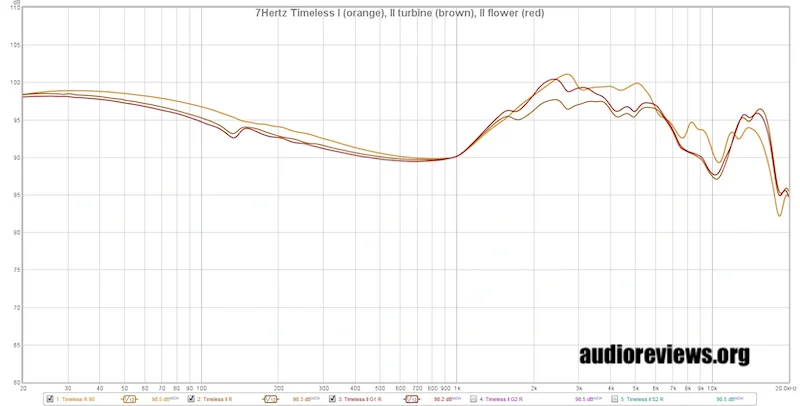
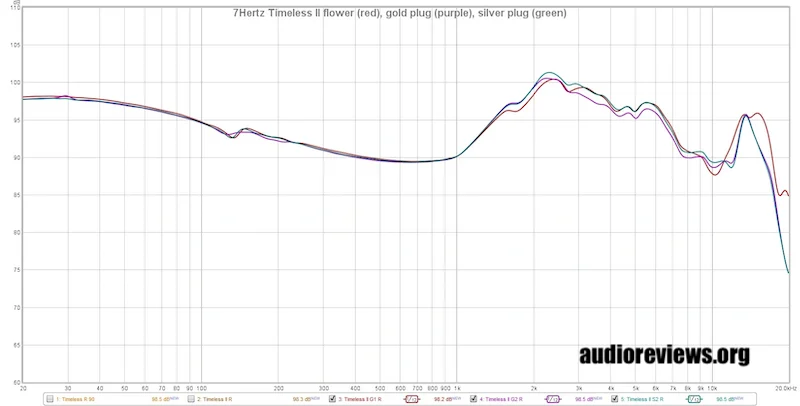
Synergy
While their slightly higher sensitivity makes essentially zero practical difference – you’ll turn them up just as much – the higher dynamics & faster leading-edge transients of the Timeless II make them less demanding of source components than the originals. Even straight out of a phone (yes, I still have one with a headphone jack) they’re more than acceptable, although their relatively low sensitivity (for IEMs) puts them near max available volume, so they’re much happier with additional amplification. The weightier lower mid timbre vs the originals makes the Timeless II less demanding of source warmth, too, so overall the new versions have more flexibility in how they’re fed than the old.
Concluding Thoughts
If it’s not obvious by now or if you’ve skipped over the boring stuff above in order to get straight to this part: I like these a lot, and would recommend them over the originals (which I still think are good in their own right). The new drivers improve the response at both ends and the timbre and technicalities throughout; they come with interchangeable nozzles that – unlike some other examples – do actually make a difference in the critical upper mid/lower treble area (although I’m not sure I can relate to the spatial portrayals of the ‘dome’ ones); and the included cable can be used with balanced or SE sources. Their current price at Linsoul of $US 229 represents an impressive value uptick over the $US 199 of the original version (still available there).
The caveat – for both versions – is whether the large and odd-shaped shells, even if they fit, will interact with your particular ears to give unpleasant results. If you disliked the original version, it’s probable that the Timeless II will not significantly change your experience. If on the other hand you liked the originals or wished only for minor improvements, these new ones should be on your radar.
Specifications 7Hz Timeless II
| THD | <0.2%/1KHz |
| Driver | 14.5mm planar driver |
| Impedance | 15.2 ohm |
| Connectors | 0.78mm 2-pin |
| Sensitivity | 108db/V@1KHz [90.4 dB/mW] |
| Frequency Response | 5-40,000 Hz |
| Weight per Earpiece | 5 g |
| Tested At | $229.99 USD |
| Purchase Link | Linsoul |
Disclaimer
Provided to us by Linsoul for review.
Our generic standard disclaimer.
You find an INDEX of our most relevant technical articles HERE.



